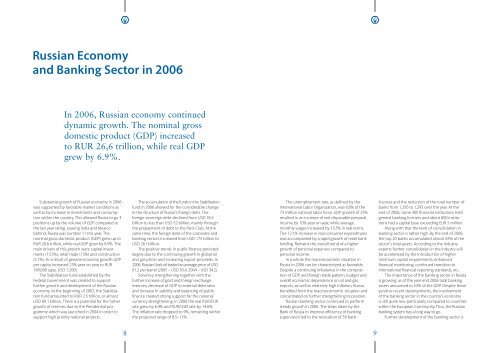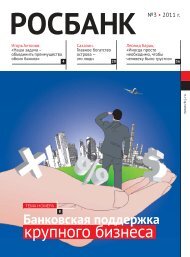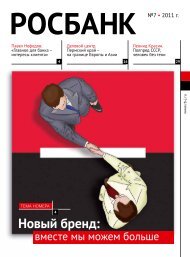Corporate Banking
Corporate Banking
Corporate Banking
You also want an ePaper? Increase the reach of your titles
YUMPU automatically turns print PDFs into web optimized ePapers that Google loves.
Russian Economy<br />
and <strong>Banking</strong> Sector in 2006<br />
In 2006, Russian economy continued<br />
dynamic growth. The nominal gross<br />
domestic product (GDP) increased<br />
to RUR 26,6 trillion, while real GDP<br />
grew by 6.9%.<br />
Substantial growth of Russian economy in 2006<br />
was supported by favorable market conditions as<br />
well as by increase in investments and consumption<br />
within the country. This allowed Russia to go 3<br />
positions up by the volume of GDP compared to<br />
the last year rating. Leaving India and Mexico<br />
behind, Russia was number 11 this year. The<br />
nominal gross domestic product (GDP) grew up to<br />
RUR 26,6 trillion, while real GDP grew by 6.9%. The<br />
main drivers of this growth were capital investments<br />
(13.5%), retail trade (13%) and construction<br />
(5.1%). As a result of general economy growth GDP<br />
per capita increased 25% year on year, to RUR<br />
189,000 (app. USD 7,200).<br />
The Stabilization fund established by the<br />
Federal Government was created to support<br />
further growth and development of the Russian<br />
economy. At the beginning of 2007, the Stabilization<br />
fund amounted to RUR 2.3 trillion, or almost<br />
USD 89.1 billion. There is a potential for the futher<br />
growth of reserves due to the Presidential programme<br />
which was launched in 2004 in order to<br />
support high priority national projects.<br />
The accumulation of the funds in the Stabilisation<br />
fund in 2006 allowed for the considerable change<br />
in the structure of Russia’s foreign debt. The<br />
foreign sovereign debt declined from USD 76.5<br />
billion to less than USD 52 billion, mainly through<br />
the prepayment of debt to the Paris Club. At the<br />
same time, the foreign debt of the corporate and<br />
banking sectors increased from USD 175 billion to<br />
USD 261 billion.<br />
The positive trends in public finance persisted<br />
largely due to the continuing growth in global oil<br />
and gas prices and increasing export proceeds. In<br />
2006, Russian Urals oil traded an average price of USD<br />
61.2 per barrel (2005 – USD 50.4, 2004 – USD 34.2).<br />
Solvency strengthening together with the<br />
further increase of gold and foreign exchange<br />
reserves, decrease of GDP to external debt ratio<br />
and increase in stability and balancing of public<br />
finance created strong support for the national<br />
currency strengthening. In 2006 the real RUR/EUR<br />
rate grew by 6.4% and RUR/USD rate by 14.6%.<br />
The inflation rate dropped to 9%, remaining within<br />
the projected range of 8.5–11%.<br />
The unemployment rate, as defined by the<br />
International Labor Organization, was 6.8% of the<br />
73 million national labor force. GDP growth of 25%<br />
resulted in an increase of real disposable personal<br />
income by 10% year on year, while average<br />
monthly wages increased by 13.5% in real terms.<br />
The 12.1% increase in real consumer expenditures<br />
was accompanied by a rapid growth of retail bank<br />
lending. Remains the overall trend of a higher<br />
growth of personal expenses compared to<br />
personal income.<br />
In a whole the macroeconomic situation in<br />
Russia in 2006 can be characterized as favorable.<br />
Despite a continuing imbalance in the composition<br />
of GDP and foreign trade pattern, budget and<br />
overall economic dependence on oil and gas<br />
exports, as well as relatively high inflation, Russia<br />
benefited from the macroecomomic situation and<br />
concentrated on further strengthening its position.<br />
Russian banking sector continued to perform<br />
steady growth in 2006. The steps taken by the<br />
Bank of Russia to improve efficiency of banking<br />
supervision led to the revocation of 59 bank<br />
licenses and the reduction of the total number of<br />
banks from 1,356 to 1,293 over the year. At the<br />
end of 2006, some 300 financial institutions held<br />
general banking licenses and about 600 institutions<br />
had a capital base exceeding EUR 5 million.<br />
Along with that the level of consolidation in<br />
banking sector is rather high. By the end of 2006,<br />
the top 20 banks accumulated almost 65% of the<br />
sector’s total assets. According to the industry<br />
experts further consolidation in the industry will<br />
be accelerated by the introduction of higher<br />
minimum capital requirements, enhanced<br />
financial monitoring, continued transition to<br />
international financial reporting standards, etc.<br />
The importance of the banking sector in Russia<br />
is growing: as of the year end 2006 total banking<br />
assets amounted to 53% of the GDP. Despite these<br />
positive recent developments, the involvement<br />
of the banking sector in the country’s economy<br />
is still quite low, particularly compared to countries<br />
within the European Community. Thus, the Russian<br />
banking system has a long way to go.<br />
Further development of the banking sector is








